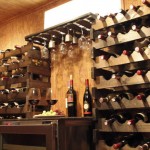Protecting Your Wine Investment
Some may think that keeping wine at the proper temperature is sort of a wine snob thing, but it isn’t. Many bottles of wine have been rendered undrinkable because the owners of these wonderful bottles don’t know the correct storage and transportation temperatures.
Never, Ever Leave Wine in a Hot Car
 Just about the only complaints we get about our wine “tasting different” or “going bad” are because customers have put the wine in the trunk or the back seat on a hot day and headed for the beach or shopping. Nothing will destroy a nice bottle of wine faster than heating it up to 50 degrees Celsius and then cooling it to 20 or lower. The heat causes enzymatic and chemical reactions in the wine and then the drop in temperature sucks a ton of oxygen into the bottle where it will oxidize and perhaps give bacteria a foothold to truly spoil the wine. It can happen overnight.
Just about the only complaints we get about our wine “tasting different” or “going bad” are because customers have put the wine in the trunk or the back seat on a hot day and headed for the beach or shopping. Nothing will destroy a nice bottle of wine faster than heating it up to 50 degrees Celsius and then cooling it to 20 or lower. The heat causes enzymatic and chemical reactions in the wine and then the drop in temperature sucks a ton of oxygen into the bottle where it will oxidize and perhaps give bacteria a foothold to truly spoil the wine. It can happen overnight.
Keep the wine in an air conditioned car or a cooler while you travel and get it into the place you’re staying as soon as you arrive. If you’re at a comfortable temperature in the car or at the hotel, the wine will be fine but it will last a lot longer if it’s stored properly at your final destination.
Proper Long-Term Storage
Here’s why getting the right temperatures for your wine is important when you’re not planning to drink the bottle right away:
 White wines can be stored at lower ranges at 45ºF (7 degrees Celsius). Reds require 50 to 55 degrees Fahrenheit (10 to 16 degrees Celsius).
White wines can be stored at lower ranges at 45ºF (7 degrees Celsius). Reds require 50 to 55 degrees Fahrenheit (10 to 16 degrees Celsius).
Light – Red wine bottles are made of dark colored glass for good reason… to keep the light out. When a white or red wine is exposed to light, whether sunlight or artificial light, it begins to oxidize and age prematurely.
Heat – Just like light, exposure to heat causes wine to oxidize and prematurely age.
Humidity – If a wine storage room is too humid, mold and mildew tend to form on the bottle and the label. If wine is stored in a room that is not humid enough, then the cork dries out and air gets into the bottle wine. Plastic corks are not affected in this way but humidity is still something to watch out for.
If you don’t have a cellar for storage:
If you aren’t an avid wine collector and just happen to have bought or received a few nice bottles of wine you plan to hold, you probably don’t want to go through the expense of buying a wine refrigerator or building a wine cellar in your home. You can store wine in other places of your home, but not for as long as you can in a wine refrigerator. Here are the two best places:
Basement – Store your wine away from any appliances like washers, dryers and hot water heaters. Place it on the floor, as the temperature near the floor remains the coolest and the most constant, in a dark closet or corner. Your wine will keep for one to two years if stored this way.
Closet – If you don’t have a basement, store your wine in the bottom of a dark, rarely used closet. Be aware that you don’t want to store your wine in a closet for more than a year.
Where Not to Store Wine:
As mentioned above, you don’t want to store wine near any heat source what so ever. That being said, the kitchen should never be a consideration for wine storage. Even if you have a beautiful bakers rack with a wine rack off the bottom shelf, resist the urge to store your red wine bottles there. The heat and humidity fluctuations from a running refrigerator, stove and dishwasher ruin wine over time.